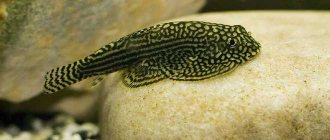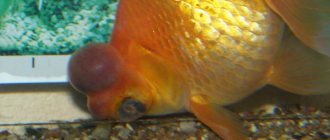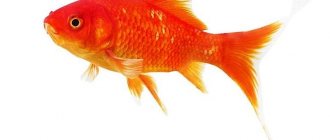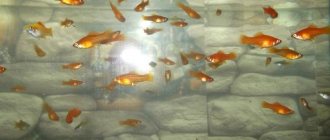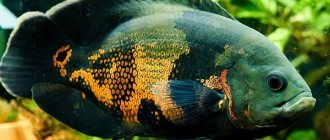4.9
(17)
Modern aquarists, when they decide to have a small corner of the underwater world at home, try to choose some interesting and unusual inhabitants for it. Of course, this is not surprising, because any aquarium should be a decoration of the home, and the more attractive the individuals in it, the better.
However, there are those fish that are already familiar to everyone, but have such a non-standard appearance that they still do not lose their popularity, even against the backdrop of various new products like thorns or GloFish zebrafish. We are talking about the oranda, which is essentially a type of goldfish.
General information and habitat in nature
Oranda is a short-bodied goldfish bred by Chinese aquarium breeders in the 15th century. It is one of the types of veil tail and is represented by several variations, which differ slightly in external characteristics - the location and size of the growths.
The red cap belongs to the decorative aquarium fish from the Carp family. This breed is highly valued in the East, here they are called “Water Flowers”. Based on the oranda, breeders have developed dozens of original hybrids, including by crossing with other goldfish.
All goldfish, and oranda is no exception, are created artificially. Through long and careful selection. They don't exist in nature.
Reviews
The opinions of aquarists who bought red cap aquarium fish vary. Although initially the beauty and calm disposition win the hearts of buyers, later problems arise in caring for the red cap fish. Novice aquarists who have overestimated their strengths complain about the difficulties of keeping a pet. The main reason for difficult care is the large amount of released organic matter. And if the aquarium is not properly cleaned, mold, brown algae appear, and the water becomes cloudy.
Description of appearance
The main feature of the fish is its warty fat formations. Orandas do not have a specific color - a variety of variations are possible. There are fish with a predominance of red, black, blue, as well as their various combinations.
An interesting combination of a completely white body with a red-orange “pompom” located on the head. For some, the fatty growth resembles a flower, for others it resembles tangerine slices - each viewer has their own associations.
Other features of the appearance of the red riding hood:
- The body is shortened. The shape resembles an ellipse.
- On average, the length of the fish reaches 15-20 cm. Some specimens grow up to 25 cm.
- The body has an unpaired dorsal fin. And the long tail limb makes up about 70% of the body. All fins are elongated and transparent.
- The tail fins are forked. And they have rounded blades.
Thanks to its bright and contrasting color, the fish with a red growth has become the most popular variety of oranda.
Price
The cost depends on their age and size. The value increases depending on the size of the red wen on the head and the length of the caudal fin.
| Size, cm | Cost, rubles |
| Fry, 1–2 | 100 |
| Grown-up fry, 2–5 | 200 |
| Teens, 6–8 | 250 |
| Adults, 9–15 | 350 |
| Large representatives, 15–20 | 400–500 |
How are males different from females?
Sexual differences in red caps are weakly expressed, so it is difficult to determine the sex of the fish. But there are, at least presumably, some signs that help establish gender, and you need to focus on them when selecting couples.
Gender differences:
- females are slightly larger and more massive than males;
- The body of males is more elongated;
- Before spawning, males become brighter and have white speckles on their heads.
History of appearance
The exact date of hatching of neither goldfish nor red cap has been established. It is only known that their selection was carried out for a long time in China. The history of breeding aquarium fish dates back centuries and continues to this day.
The ancestor of the oranda is the silver carp. It is also known that its ancestor was the veiltail fish. And it was bred on the basis of the Riukin breed - this is a humpbacked goldfish bred in Japan.
When breeding oranda, selection was carried out according to several external characteristics:
- shortened body;
- growth on the head;
- size and color.
For selection, fish with the largest growths on the head were selected. The larger the “cap”, the more valuable the fish. The cost of the red riding hood and other orandas also depends on the size of the pompom.
Distribution area
The homeland of goldfish is China, where this variety was first bred more than 1600 years ago, the ancestor of the species was the veiltail. To breed the oranda, several typical traits were used (they were the main ones for selection):
- shortened body;
- dimensions;
- bright color;
- growth-like formations.
The exact date of species appearance cannot be determined. The spectacular beauty inhabited the ponds of the estates of important people and wealthy nobility. Oranda first came to our country in the 17th century. and immediately gained popularity. In Asian countries, the generally accepted name for this breed is “Tsziyu”. The term “goldfish” originated only among the Slavic peoples.
The fleshy growth on the fish is called “wen”. When it grows in size, the fish stops seeing. In this case, the growth is carefully trimmed (there are no nerve endings in the vein, so this procedure is painless). The fish are given only a sedative.
Kinds
In addition to the red cap, there are a large number of orandas of other colors. All of them have a large fatty growth on the head, as well as a separate name.
Popular types of oranda:
- Chocolate. They have a chocolate brown body and a slightly darker growth.
- Black. There are golden specks on the coal-black velvety body. The growth is also black, but the belly is light golden.
- Calico. This species has a pale golden-red color. Spots of different colors are scattered throughout the body.
- Reds. Both the body and the cap are red. To make the fish more vibrant, it is fed dry food that contains natural color enhancers.
- Blue. These fish have bodies ranging from gray to blue.
- Giroshima. It is distinguished by fluffy growths near the mouth. The color of the pompom is red, white, blue.
Diseases
Fish can develop diseases of the gastrointestinal tract. To prevent such diseases, you should use special mixtures or feed the fish with live food. There should be coarse soil at the bottom of the aquarium.
An aquarium for goldfish should be: large in volume, not round, with a minimum number of plants, large jackdaws and without sharp decorations.
Since orandas often burrow in the ground, they can swallow pebbles. Unfortunately, it is impossible to help the fish in this case.
If you do not change the water in the aquarium in a timely manner and do not aerate it, then the nitrate content in it may increase several times. These compounds cause fish death.
At low temperatures, the likelihood of developing ichthyophthyriosis increases. Small whitish grains appear on the body of the fish. In the early stages, the disease is curable.
Behavior
Although the red riding hood is a large fish, it is very calm and rarely gets into fights. This species is completely non-conflicting and is able to peacefully coexist with fish of other species. Usually they have a neutral attitude towards their neighbors and simply do not notice them.
The fish is quite sociable, it does not like loneliness, it is better to keep it in small schools. All orandas like to gather in groups. They are slow, clumsy, and do not rush around aquariums, like, for example, fast-moving comets. Because of this, even small fish can attack them.
The favorite activities of red riding hoods are to parade in flocks, dig in the soil, undermine the roots of plants and bite their leaves.
Origin of the Flower Horn Cichlid
Flower Horn is believed to have originated in Malaysia in 1993, although many Malayan fish farmers only received breeding material in the 1980s. The Malays took a liking to a fish with a prominent protrusion on its forehead, called Kaloi or "warship", which they discovered in the western part of the country. This hybrid probably arose from a cross between Cichlasoma festae and Cichlasoma trimaculatus. In Thai society, the cichlid with a slightly prominent forehead and long tail was highly valued, since it was believed that it brings good luck in geomancy (Eastern Feng Shui), or the art of harmonizing space through the correct arrangement of objects. In 1994, Amphilophus labiatus and Amphilophus trimaculatus from Central America, and blood parrot cichlid from Taiwan were imported into Malaysia.
In 1995, crossbreeding programs with Amphilophus labiatus gave the early Flower Horn human- or ape-like facial features. The hybrid was aptly dubbed the “Human Face Red God of Fortune.” This hybrid was then crossed with the Red Parrot hybrid to create the Five-Colors God of Fortune. Thanks to its beautiful colors, the fish quickly gained popularity. In 1998, they were crossed with the so-called seven-color Blue Fiery Mouth (also known as Greenish Gold Tiger) cichlids, which were imported from Central America, and the Taiwanese Red Parrot hybrid, "King Kong" ("Jin Gang"). This crossing resulted in the first generation of Flower Horn hybrids "Hua Luo Han". Modern Flower Horns are descendants of “Hua Luo Han” individuals.
Compatibility
It is not recommended to keep the red cap in an aquarium with aggressive fish species. Even if these “aggressors” are much smaller in size. The danger threatens, first of all, the fins - barbs, cockerels and swordtails, in particular, like to bite them.
Neons and mollies are also considered undesirable neighbors. Orandas can swallow small fish.
It is recommended to house Little Red Riding Hood with fish that have a peaceful nature; she gets along best with:
- telescopes;
- comets;
- Shubunkin fish;
- guppy;
- cardinals;
- zebrafish;
- thorns;
- catfish
Care of offspring
Spawning usually begins in the morning and lasts several hours. When it ends, the fish are returned to their original aquarium, and the water in the spawning tank is reduced. Caviar can be transferred to smaller containers. Whitish and cloudy unfertilized eggs should be disposed of immediately, as they pollute the water. Snails can also cope with this task perfectly.
The caviar should be well lit, but it should not be overheated. Containers should not be placed in direct sunlight. The fry hatch in 3-4 days. They are given live dust as food. As they grow, young specimens are separated by size into different aquariums, otherwise the larger specimens will eat the smaller ones.
Content
For successful development and reproduction, certain care and conditions are required. The water parameters and equipment of the aquarium are important. If the fish do not live in a favorable environment, they will live less than the allotted time.
Cleaning and care
Orandas have a reputation for slobs. In fact, they don't pollute aquariums any more than other fish species. Cleaning is carried out infrequently - once every 2-4 weeks. The idea of sloppiness arose from the gluttony of goldfish.
Approximately 30% of the water in the aquarium needs to be changed weekly. It must be clean and at the appropriate temperature.
Aquarium
The volume of the aquarium for one red cap is at least 50 liters. A small school of 3-4 fish is placed in an aquarium with a capacity of 150-200 liters.
Aquarium requirements:
- minimum number of decorations;
- hiding places are less important than a large aquarium volume.
Water parameters
The health and well-being of the red cap largely depends on water parameters. Violation of even one requirement can lead to illness and even death of the fish.
Recommended water parameters:
- temperature - from +16 to +24°C;
- acidity - pH 5-8;
- hardness - from 6 to 18°.
Overheating is just as dangerous to redcaps as cold, so the aquarist should regularly check the water temperature and make adjustments if necessary.
Plants
There are only two colors in the red cap - red and white, so they look especially beautiful against the background of green aquarium vegetation. These fish love to have all kinds of underwater flora growing next to them. They willingly bite its leaves, and dig up and gnaw its roots.
What plants are suitable for aquariums with orandas:
- with hard leaves;
- with strong roots;
- artificial vegetation.
Taking into account the behavioral characteristics of orandas, it is recommended to plant their aquarium with Congolese or Thai fern, Aponogeton rigidifolia, Microsporium, Echinodorus, and Anubias.
Priming
One of the peculiarities of the oranda’s behavior is digging up the soil, which must be taken into account when choosing the material to be poured onto the bottom of the aquarium. To keep the water as dirty as possible, use river sand. Pebbles and gravel are also suitable.
Do not place large stones on the bottom, especially those with sharp edges - the fish may get injured on them.
Equipment
Fish need clean, oxygenated water. To prevent red caps from suffocating and to feel good, the aquarium is equipped with special devices that purify the water and saturate it with oxygen molecules.
What equipment will you need:
- aerating device;
- filter;
- compressor.
If you install all of the above devices, the fish will receive a favorable habitat. Otherwise, their body will suffer from negative influences, which will ultimately lead to health problems.
Lighting
The aquarium needs artificial lighting. All fish benefit from direct ultraviolet rays, but sunlight alone is not enough.
Fish need additional light not only for their well-being, but also for their beautiful coloration. The more and brighter the light, the more intense the coloring of the fish. In dim lighting, the red growths turn pale and the orandas lose their decorative properties.
Breeding
To breed orandas, you will need a spawning tank with a volume of 30-50 liters, as well as 2 males and a female. Fish become sexually mature at the age of 1.5-2 years. It is possible to distinguish a male from a female only during the spawning period. Plants with small leaves are placed in the spawning tank. Before spawning, the spawners are placed in separate containers and fed well. In the evening, the males and females are placed in the spawning tank. Spawning most often occurs early in the morning.
As soon as the spawning is over, the parents are removed from the spawning area. The aquarist needs to inspect the eggs and remove dead white eggs. Larvae appear on 4-5 days. They hang on the glass and receive nutrition from the yolk sac for 2-3 days. When the young swim, they should be given food. The fry grow unevenly, so they are sorted and seated.
Feeding and diet
Red caps are very voracious and almost omnivorous. They like plant and animal food, dry or live. They also love to nibble and eat plants, which is another important addition to their diet.
Nutrition Features:
- It is recommended to feed red caps with specialized food. Designed for goldfish. Dry food needs to be balanced - containing a full range of nutrients.
- The optimal food for all orandas is vegetation. What they love most is spinach and lettuce. But they must be supplemented with all kinds of small animals and balanced dry food.
- An important requirement for dry food is good digestibility. If undigested food particles get into the water, it becomes more polluted and faster. To prevent voracious fish from becoming obese, it is necessary to adhere to a strict diet.
- Feed the fish in small portions. All food should be eaten at one time, nothing should remain in the water. The daily food intake is no more than 3% of the fish’s weight.
- Fish must necessarily receive animal food. It is better to buy it frozen. It is recommended to include in their diet: tubifex;
- Artemia;
- daphnia;
- bloodworm.
If a red cap floats on its side on the surface of the water, it means it has overfed. If this situation occurs frequently, the fish may have an intestinal disease.
The best food for little red riding hood is considered to be products from Tetra. In its line you can choose the ideal food for these fish.
Tetra food suitable for Little Red Riding Hood:
- Goldfish Gold Japan. Dry granulated food. Premium products are ideal for feeding all goldfish. After the food softens, it sinks to the bottom. There the roars search for him, satisfying their habit of rummaging in the ground. The food contains plant proteins that improve digestion.
- Tetra Goldfish for goldfish. This is a specialized line produced in the form of flakes, granules, chips, and sticks. The food is well digestible, reduces fish waste, which allows the water to remain clean longer.
- TetraPro Algae. This food is suitable for regular feeding. Contains spirulina concentrate.
It is recommended to arrange fasting days for red caps every week.
Suitable neighborhood
Oranda is usually kept in a separate (species) aquarium. A clumsy and slow fish cannot resist active, curious species (barbs, irises, etc.), which will pursue orandas and spoil their luxurious tails and fins. You should not add large oranda fish to small fish that can fit in the mouth of a goldfish.
But they can find suitable neighbors from the same slow-moving aquarium inhabitants:
telescopes
veiltails
Shubunkins
Ancitrus catfish will also be suitable neighbors. Peace-loving creatures hide in shelters during the day. To prevent voracious orandas from taking food from the catfish, you need to feed the ancitrus in the evening, throwing them bottom nutritional tablets before turning off the lights.

